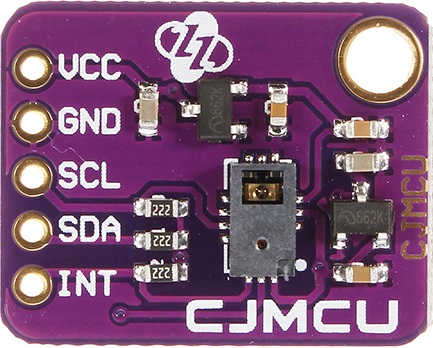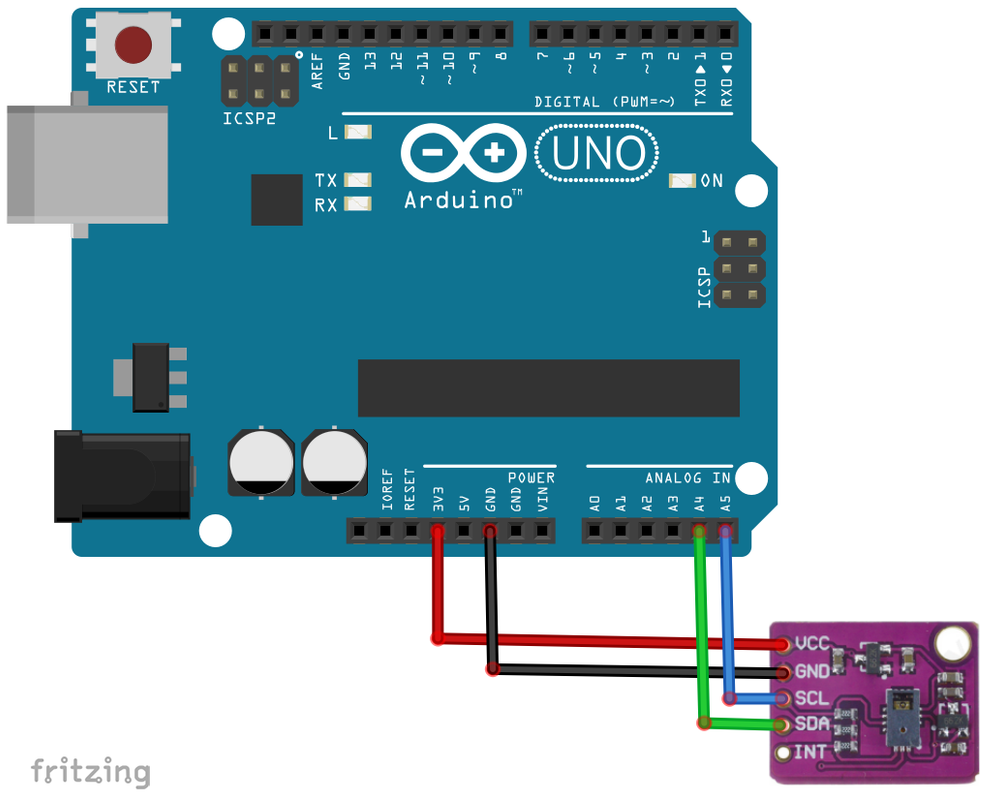AED 30.45
Description
The CJMCU-7620 gesture recognition sensor is a PAJ7620U2 that combines the universal I2C interface with the gesture recognition functionality on a single chip. It can recognize nine different gestures, including those that move up, down, left, right, forward, backward, clockwise, circumferentially, counterclockwise, downward, downward, from left to right, and from left to right. The I2C bus provides access to gesture information. The PAJ7260u2 body infrared recognition IC, which allows communication with the I2C protocol, is created with the CJMCU-7620 gesture recognition sensor module as its core chip.
Package Includes:
- 1 x The CJMCU-7620 gesture recognition sensor
Features:
- The CJMCU-7620 is a module that enables gesture recognition in electronic devices.
- The module is easy to use and compact, making it ideal for use in a variety of applications such as gaming, home automation, and robotics.
- The sensor detects body infrared signals and the PAJ7260u2 infrared recognition IC processes this information and communicates with other devices through the I2C bus.
- The sensor is designed to recognize up to nine different gestures, including up, down, left, right, forward, backward, clockwise, counterclockwise, and waving from left to right and right to left.
- The sensor's low power consumption makes it ideal for use in battery-powered devices.
- The CJMCU-7620 module is a cost-effective solution for adding gesture recognition functionality to electronic devices.
Description:
The CJMCU-7620 gesture recognition sensor is a highly specialized sensor that combines the universal I2C interface with gesture recognition capabilities in a single chip. It is powered by a PAJ7620U2 chip and is capable of recognizing nine different gestures, including up, down, left, right, forward, backward, clockwise, counterclockwise, and waving from left to right and right to left. This sensor module communicates with other devices through the I2C bus, providing easy access to the detected gesture information. The CJMCU-7620 is equipped with a PAJ7260u2 body infrared recognition IC, which allows for communication with the I2C protocol. The module is easy to use and can be incorporated into a wide range of electronic devices and systems that require gesture recognition functionality. With its compact form factor and low power consumption, it is a cost-effective solution for adding gesture recognition capabilities to any project.
Principle of Work:
The CJMCU-7620 gesture recognition sensor works by detecting body infrared signals and processing them to recognize different gestures. The sensor module uses the PAJ7620U2 gesture recognition chip, which combines the universal I2C interface with gesture recognition functionality on a single chip. When a person moves their hand in front of the sensor, the body infrared signals are detected by the PAJ7260u2 body infrared recognition IC, which is part of the CJMCU-7620 module. The infrared recognition IC processes the signals and communicates with other devices through the I2C bus. The PAJ7620U2 chip uses a library of predefined gesture recognition patterns to recognize different hand movements. The chip can recognize up to nine different gestures, including up, down, left, right, forward, backward, clockwise, counterclockwise, and waving from left to right and right to left. Once the gesture is recognized, the sensor module sends the corresponding signal to the microcontroller or other electronic device, which can then use this information to trigger a specific action. This allows electronic devices to be controlled with simple hand gestures, making them more intuitive and user-friendly.
Pinout:

- GND: Ground pin
- VCC: Power supply pin, typically 3.3V or 5V
- SCL: I2C clock pin
- SDA: I2C data pin
- INT: Interrupt output pin, used to notify the host controller of gesture events
Applications:
- Smart homes: The sensor can be used to control various devices and appliances using hand gestures, such as turning on/off lights, adjusting thermostat settings, opening/closing blinds, etc.
- Consumer electronics: The sensor can be used in various gadgets and devices, such as smartphones, smartwatches, and TV remotes, to enable gesture-based control.
- Gaming: The sensor can be used in gaming consoles and devices to enable gesture-based gameplay and control.
- Robotics: The sensor can be used in robotic systems to enable gesture-based control and communication between humans and robots.
- Automotive: The sensor can be used in cars and other vehicles to enable gesture-based control of various functions, such as adjusting the volume of the radio or changing the temperature of the AC.
- Healthcare: The sensor can be used in healthcare devices and systems to enable gesture-based control of various functions, such as adjusting the position of a hospital bed or controlling medical equipment.
Circuit:

Library:
Install the CJMCU7620 library in the Arduino IDE:
- Open the Arduino IDE.
- Go to the Sketch menu and select "Include Library".
- Select "Manage Libraries" from the drop-down menu.
- In the "Library Manager" window, type "CJMCU7620" in the search bar and press Enter.
- Find the CJMCU7620 library in the search results and click on it.
- Click the "Install" button and wait for the installation to finish.
- Once the installation is complete, close the Library Manager window.
The CJMCU7620 library should now be installed and ready to use in your Arduino sketches.
Code:
example Arduino sketch that uses the CJMCU7620 library to read gesture data from the CJMCU-7620 sensor and output it to the serial monitor:
#include "CJMCU7620.h"
CJMCU7620 sensor;
void setup() {
Serial.begin(9600);
while (!Serial) {} // wait for serial port to connect
sensor.begin();
sensor.setGestureMode();
}
void loop() {
int gesture = sensor.readGesture();
if (gesture != -1) {
Serial.print("Gesture detected: ");
Serial.println(gesture);
}
delay(100); // poll sensor every 100ms
}
This code uses the CJMCU7620 library, which simplifies the process of communicating with the CJMCU-7620 sensor by providing a set of easy-to-use functions. The sensor.begin() function initializes the sensor and sensor.setGestureMode() puts the sensor into gesture mode. The sensor.readGesture() function reads the gesture data from the sensor and returns -1 if no gesture is detected.
Technical Details:
- 9 gesture recognition
- The gesture speed is 60 / s to 600 / s in normal mode, and the game mode is 60 / s to 1200 / S
- Environmental light immunity: <100k Lux
- Built-in proximity detection
- The I2C interface is up to 400 kbit / S
- The typical supply voltage is 2.8V to 3.3V and I/O voltage is 1.8V~3.3V
- Nine gesture recognition (Up / Down / Left / Right / Push / Pull / CW / CCW / Wave)
- Gesture speed is 60°/s to 600°/s in Normal Mode and 60°/s to 1200°/s in Gaming Mode
- Ambient light immunity: < 100k Lux
- Built-in proximity detection
- Flexible power-saving scheme
- I2C interface up to 400 kbit/s, Pull-up voltage from 1.8V to 3.3V
- Ambient light noise cancellation
Resources:
Comparisons:
the APDS-9960 and the CJMCU-7620 are gesture recognition sensors that use optical sensing technology to detect hand and finger movements. However, there are some differences between the two sensors:
- Sensing capabilities: The APDS-9960 is capable of detecting four different types of gestures (up, down, left, and right swipe) as well as proximity and ambient light. In addition to these, the CJMCU-7620 can detect more complex gestures such as clockwise and counterclockwise circles and "wave" gestures.
- Operating voltage: The APDS-9960 operates at a wider range of voltages (2.4V - 3.6V) compared to the CJMCU-7620 (3.3V).
- Communication protocol: Both sensors use I2C to communicate with the host microcontroller, but the APDS-9960 also supports the SPI interface.
- Availability: The APDS-9960 is a widely-used gesture recognition sensor that is readily available from many different manufacturers, whereas the CJMCU-7620 is a less common sensor that may be harder to find.
- Price: The CJMCU-7620 is generally less expensive than the APDS-9960, which may make it a more attractive option for cost-sensitive projects.